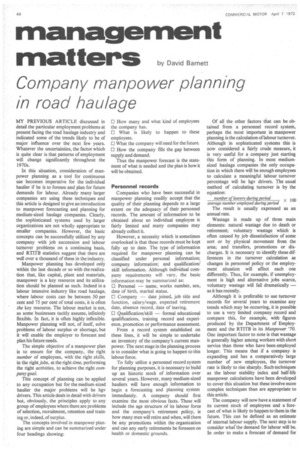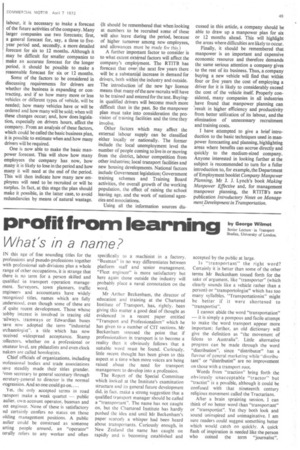management
Page 46

Page 47

If you've noticed an error in this article please click here to report it so we can fix it.
matters by David Barnett
Company manpower planning in road haulage
MY PREVIOUS ARTICLE discussed in detail the particular employment problems at present facing the road haulage industry and indicated some of the trends likely to be of major influence over the next few years. Whatever the uncertainties, the factor which is quite clear is that patterns of employment will change significantly throughout the 1970s.
In this situation, consideration of manpower planning as a tool for continuous use becomes imperative for the individual haulier if he is to foresee and plan for future demands for labour. Already many larger companies are using these techniques and this article is designed to give an introduction to manpower forecasting and planning for medium-sized haulage companies. Clearly, the sophisticated systems used by larger organizations are not wholly appropriate to smaller companies. However, the basic concepts can be successfully utilized by any company with job succession and labour turnover problems on a continuing basis, and RTITE statistics suggest that there are well over a thousand of these in the industry.
Manpower planning has developed only within the last decade or so with the realization that, like capital, plant and materials, manpower is a key resource and its utilization should be planned as such. Indeed in a labour intensive industry like road haulage, where labour costs can be between 50 per cent and 75 per cent of total costs, it is often the key resource. The labour market is not, as some businesses tacitly assume, infinitely flexible. In fact, it is often highly inflexible. Manpower planning will not, of itself, solve problems of labour surplus or shortage, but it will enable the employer to forecast and plan his future needs.
The simple objective of a manpower plan is to ensure for the company, the right number of employees, with the right skills, in the right jobs, at the right time, performing the right activities, to achieve the right company goal.
This concept of planning can be applied to any occupation but for the medium-sized haulier the major problems will be hgv drivers. This article deals in detail with drivers but, obviously, the principles apply to any group of employees where there are problems of selection, recruitment, retention and training or, indeed, of surplus.
The concepts involved in manpower planing are simple and can be summarized under four headings showing: O How many and what kind of employees the company has.
O What is likely to happen to these employees. 0 What the company will need for the future.
O How the company fills the gap between supply and demand.
Thus the manpower forecast is the statement of what is needed and the plan is how it will be obtained.
Personnel records Companies who have been successful in manpower planning readily accept that the quality of their planning depends to a large extent on the adequacy of their personnel records. The amount of information to be obtained about an individual employee is fairly limited and many companies may already collect it.
However, a necessity which is sometimes overlooked is that these records must be kept fully up to date. The type of information required for manpower planning can be classified under personal information; company information; and qualification/ skill information. Although individual company requirements will vary, the basic information may be summarized as: • Personal — name, works number, sex, date of birth, marital status.
O Company — date joined, job title and function, salary/wage, expected retirement date, absence record, date of leaving.
O Qualification/skill — formal educational qualifications, training record and experience, promotion or performance assessment.
From a record system established on these lines, it will be simple to undertake an inventory of the company's current manpower. The next stage in the planning process is to consider what is going to happen to this labour force.
To fully utilize a personnel record system for planning purposes, it is necessary to build up an historic stock of information over several years. However, many medium-sized hauliers will have enough information to begin a forecasting and planning system immediately. A company should first examine the most obvious facts. These will include the age structure of its labour force and the company's retirement policy, le how many men will retire and when, will there be any promotions within the organization and can any early retirements be foreseen on health or domestic grounds. Of all the other factors that can be obtained from a personnel record system, perhaps the most important in manpower planning is the calculation of labour turnover. Although in sophisticated systems this is now considered a fairly crude measure, it is very useful for a company just starting this form of planning. In most mediumsized haulage companies the only occupation in which there will be enough employees to calculate a meaningful labour turnover percentage will be hgv drivers. The usual method of calculating turnover is by the equation: number of leavers during period X 100 average number employed during period The result is usually expressed as an annual rate.
Wastage is made up of three main elements: natural wastage due to death or retirement; voluntary wastage which is often calmed by job dissatisfaction of some sort or by physical movement from the area; and transfers, promotions or discharges. It is necessary to identify these differences in the turnover calculation as changes in personnel policy or the employment situation will affect each one differently. Thus, for example, if unemployment is high and alternative jobs scarce, voluntary wastage will fall dramatically — as it has recently.
Although it is preferable to use turnover records for several years to examine any trends which may be occurring, it is possible to use a very limited company record and compare this, for example, with figures produced by the Department of Employment and the RTITB in its Manpower '70. One important factor to note is that wastage is generally higher among workers with short service than those who have been employed longer. This means that if a company is expanding and has a comparatively large number of new employees, the turnover rate is likely to rise sharply. Such techniques as the labour stability index and half-life manpower calculations have been developed to cover this situation but these involve more complex techniques than are appropriate to this article.
The company will now have a statement of its current stock of employees and a forecast of what is likely to happen to them in the future. This can be defined as an estimate of internal labour supply. The next step is to consider whafthe demand for labour will be. In order to make a forecast of demand for labour, it is necessary to make a forecast of the future activities of the company. Many larger companies use two forecasts; first, a general forecast for, say, a three to fiveyear period and, secondly, a more detailed forecast for six to 12 months. Although it may be difficult for smaller companies to make an accurate forecast for the longer period, it should be possible to make a reasonable forecast for six or 12 months.
Some of the factors to be considered in discussing requirements for drivers are whether the business is expanding or contracting, and if so how many more or less vehicles or different types of vehicle, will be needed; how many vehicles have or will be ordered and how many will be sold; when will these changes occur; and, how does legislation, especially on drivers hours, affect the company. From an analysis of these factors, which could be called the basic business plan, it is possible to estimate when and how many drivers will be required.
One is now able to make the basic manpower forecast. This will show how many employees the company has now, how many it is likely to lose in the period and how many it will need at the end of the period. This will then indicate how many new employees will need to be recruited or will be surplus. In fact, at this stage the plan should make it possible, in the latter case, to avoid redundancies by means of natural wastage. (It should be remembered that when looking at numbers to be recruited some of these will also leave during the period, because of higher turnover among new employees, and allowances must be made for this.)
A further impolitant factor to consider is to what extent ext rnal factors will affect the company's emplo ent. The RTITB has forecast that over the next few years there will be a substanti1 increase in demand for drivers, both withir the industry and outside. The introduction of the new hgv licence means that many of the new recruits will have to be trained and entered for the test. Buyingin qualified drivers will become much more difficult than in the past. So the manpower plan must take into consideration the provision of training facilities and the time they involve.
Other factors which may affect the external labour supply can be classified either locally or nationally. The former include the local unemployment level the number of people coming to live in or moving from the district, labour competition from other industries; local transport facilities and new housing developments. National factors include Government legislation; Government training schemes and Training Board activities, the overall growth of the working population, the effect of raising the school leaving age, and the work of national agencies and associations.
Using all the information sources dis cussed in this article, a company should be able to draw up a manpower plan for six or 12 months ahead. This will highlight the areas where difficulties are likely to occur.
Finally, it should be remembered that manpower is an important and expensive economic resource and therefore demands the same serious attention a company gives to the rest of its business. Thus, a company buying a new vehicle will find that within four or five years the cost of employing a driver for it is likely to considerably exceed the cost of the vehicle itself. Properly considered, many companies in all industries have found that manpower planning can 'result in higher efficiency and productivity from better utilization of its labour, and the elimination of unnecessary recruitment and training costs.
I have attempted to give a brief introduction to the basic techniques used in manpower forecasting and planning, highlighting areas where benefits can accrue directly and quickly to the medium-sized company. Anyone interested in looking further at the subject is recommended to turn for a fuller introduction to, for example, the Department of Employment booklet Company Manpower Planning, Mr J. J. Lynch's book Making Manpower Effective and, for management manpower planning, the RT1TB's new publication Introductory Notes on Management Development in Transportation.




















































































